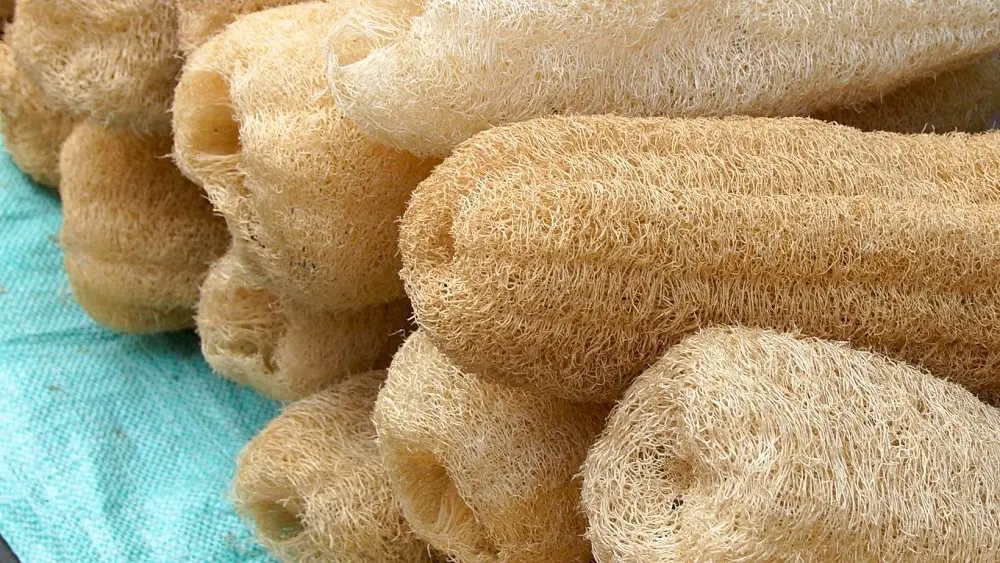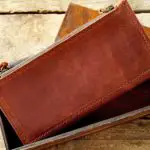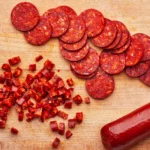Loofahs, also spelled ‘luffa’, are commonly used for cleaning in the bath and shower and are a part of many people’s daily skincare rituals.
We’ve all used some form of handy shower sponge in our lives and there are many different types, the two most common being those cute plastic frilly balls or natural-looking spongy sticks. But what exactly are these bathroom essentials made out of?
Read on to find out everything you need to know about what Loofahs are made of.
What are Natural Loofahs Made Of?
Contrary to popular belief, they are not a sea sponge at all and are made from a plant! What plant, you ask? Why the humble Egyptian Cucumber of course. Commonly called a ‘sponge gourd’ or ‘luffa’, with the Latin name ‘Luffa Aegyptiaca’, these dark green long fruits resemble a large cucumber or squash.
They are commonly grown all across the world both commercially for sale as sponges, and to be eaten as a young vegetable. This vegetable is not often found to be eaten in the United States, (much more common are our friends the squash or the cucumber) but it is widely eaten across India and other areas across the world where it is harvested young before it has the chance to grow it’s sinewy and fibrous inner netting.
How Is Natural Loofah Made?
Much like a cucumber or zucchini, the luffa plant blooms and then grows the long green gourd which is then harvested.
Then, they are left to dry for around six months, until the seeds can be heard rattling around inside the plant and all moisture has evaporated.
These are then soaked to remove the outer skin, and deseeded before drying them out again one more. Once bone-dry, the luffa is then cut or shaped as desired, a handy rope for ease of use is sometimes added and then they are ready to be packaged and sold.
How are Plastic Loofahs made?
A plastic loofah or ‘bath pouf’ is made by weaving together large soft mesh sheets of plastic to create a textured ball. Made with synthetic materials, it can come in just about any color you could think of and is even available with cute little additions sure as animal faces or soap rope attachments.
Why Use A Loofah?
Both plastic and natural loofahs act as an exfoliator for your skin. Every day your skin renews itself leaving behind a layer of dead skin sitting on top making you feel dry and dulling your skin’s natural brightness. Exfoliating removes this top layer, leaving your skin feeling silky-smooth and shiny again. Be careful not to over-exfoliate however, as this may damage your healthy skin cells underneath.
Loofahs are also great for stimulating blood flow to the area you scrub which is often linked to healthier, firmer-looking skin.
What is the difference between Plastic Loofahs and Natural Loofahs?
Plastic ones, as the name suggests, are made from synthetic man-made material and are very damaging to the environment. As it is commonly suggested to replace your bath pouf every couple of weeks to a month, this throw-away plastic item creates an unnecessary amount of plastic waste and after its short window of use sits in a landfill for hundreds of years.
As well as being harmful to the environment, recent studies have shown that they are not too great for human health either.
As we use them under running water, the microplastics escape from the bath pouf and go directly down the drain to our waterways, and may enter our local water sources.
Natural Loofahs, on the other hand, are made from entirely plant-based and non-chemical laden material from one easy-to-trace product- the Egyptian cucumber.
They are entirely compostable and as they too have a short couple of weeks to a month lifespan, you’re going to be going through a fair amount of them. So it’s nice to know they won’t be going straight into landfills.
How Do I Clean Loofahs?
Both of these products have a porous texture that makes them great for sudsing up and getting sparkly clean, but this texture is also very inviting to harmful bacteria and mold.
It is recommended to throw away your loofah if you see any sign of mold or mildew on it (no matter how cute your bath sponge is!) as it’s not worth the risk to your health.
You should wash your loofah thoroughly after every use and a deep clean is recommended every week with a strong detergent or very diluted hydrogen peroxide.
A shower room is the perfect breeding ground for bacteria- it’s warm, humid and there’s plenty of food to live off in the form of your dead skin!!
If you do not dry your loofah out properly after every use and give it a thorough cleaning, you risk inviting these horrible hosts to live on your sponge and in turn wipe back onto your body during your next pamper session!
What Can I Use Instead Of A Loofah?

Though Loofahs are an ever-popular bathroom staple, there are lots of alternatives if you don’t think they are for you. You could use a bar of soap with built-in exfoliating beads or coffee granules to cut out the middle-man entirely and still get that deep-clean feeling.
This is especially handy if you don’t think the constant cleaning and maintenance of a loofah is for you as who needs to clean a bar of sudsy soap right?
Another popular choice is the humble washcloth. Available in literally every color under the sun, it ticks the stylistic boxes and as it’s easily flung in the washing machine it’s a breeze to clean frequently.
It also has a much longer lifespan, which makes it much better from an environmental perspective than a plasti loofah.
Final Thoughts
Loofahs are made in a variety of ways and both natural and unnatural ones have their upsides and downsides.
There’s nothing quite like the scrub of a good loofah, however if the upkeep isn’t for you, there are plenty of alternatives on the market.






